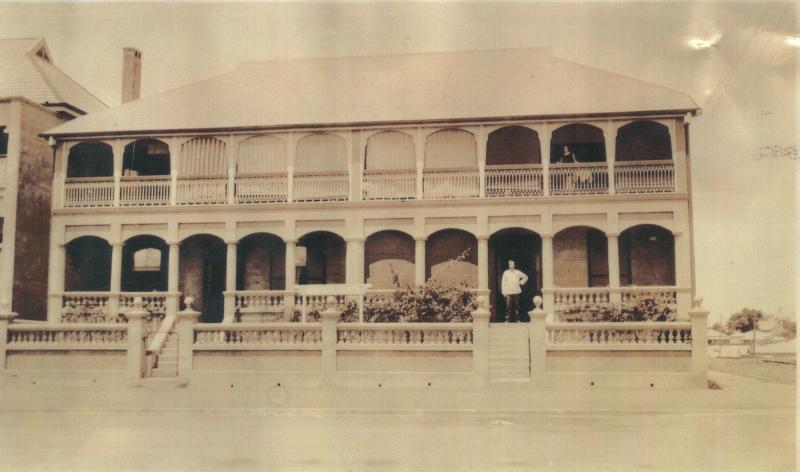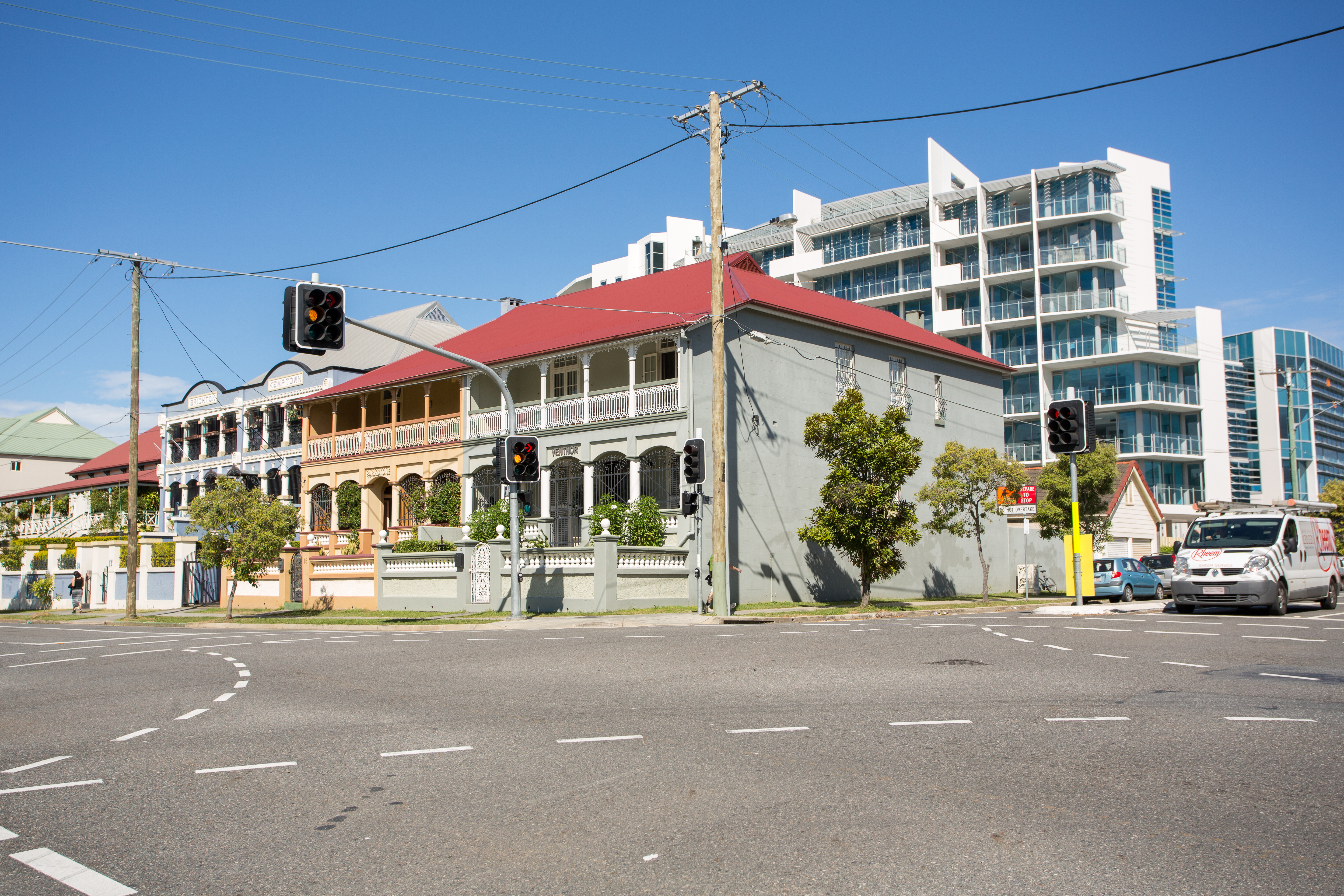Addresses
Type of place
Duplex
Period
Interwar 1919-1939
Style
Free Classical
Addresses
Type of place
Duplex
Period
Interwar 1919-1939
Style
Free Classical
This attractive duplex building was constructed in 1922 for carpenter and builder Thomas Edmonds and has been used predominantly as a rental property since that time. It is one of Brisbane’s earliest purpose-built flat buildings, constructed at the beginning of the adoption of multi-tenanted dwellings in Brisbane.
Also known as
Parkstone, Robinson & Jacitara House
Lot plan
L1_GTP1567; L2_GTP1567
Key dates
Local Heritage Place Since —
Date of Citation —
Construction
Roof: Corrugated ironCriterion for listing
(A) Historical; (D) Representative; (E) Aesthetic; (F) TechnicalInteractive mapping
Also known as
Parkstone, Robinson & Jacitara House
Lot plan
L1_GTP1567; L2_GTP1567
Key dates
Local Heritage Place Since —
Date of Citation —
Construction
Roof: Corrugated ironCriterion for listing
(A) Historical; (D) Representative; (E) Aesthetic; (F) TechnicalInteractive mapping
History
Although South Brisbane is one of Brisbane’s earliest settled suburbs, the land on which Ventnor Flats sits was not opened up for development until 1879. The site had previously been reserved as part of the Victoria Bridge Lands, which included sections of land dotted across South Brisbane. Once a permanent bridge was opened, the Victoria Bridge Lands were offered for sale. Hotelier George Booth acquired several allotments of the proffered land in August 1881. Amongst his purchases was this two allotment site, allotments 3 and 4 of section 47. The 72 perch site cost Booth £400 and faced Edmonstone [as it then was] and Russell Streets, with the longer frontage to the latter street. He had three cottages built on the site, and resided in one called ‘Croftbank’ until his death in 1920.
Booth’s heirs offered the corner block for sale in May 1920. The sale notice suggested that the site was 'eminently suitable for Factory purposes, a Doctor's Residence, or Picture Show', but new owner Thomas Edmonds focused on a different trend: flats.
Brisbane residents were slow to adapt to flat dwelling, preferring detached single family houses. Terrace houses and other multi-tenanted dwellings were discouraged by nineteenth century legislators, who were concerned about fire, disease and the development of slums. In the early twentieth century accommodation for temporary residents was provided in the form of boarding houses, usually created from old houses too large for their owners. This kind of accommodation was viewed as acceptable for city-workers and bachelors, but flat dwelling was considered to have a ‘demoralising effect’ on its inhabitants. After World War I, however, the growing population in inner-city Brisbane demanded closer development, while the exemption of flats from the Fair Rent Act 1920 encouraged investors to this new type of dwelling.
Edmonds was one of the earliest adopters of the trend. His building was one of the first – if not the first – purpose-built flat dwelling in South Brisbane, and one of the earliest in Brisbane. Edmonds, a carpenter and builder, probably constructed the brick flats himself. As flat-dwelling became more popular, a number of owner- builders constructed their own buildings as speculative investment properties, either to sell or to manage themselves.
Edmonds’ site was ideal for such investment. Its corner position enabled maximum light and air to reach the flats. It had access to transport, being a minute from the Dutton Park tramline, and within walking distance of shopping facilities, workplaces and schools. Edmonds was likely also taking advantage of the commercial and industrial growth in South Brisbane which was bringing new residents to the area. This stretch of Edmondstone Street was particularly appealing as a settled residential area, having been home to the prosperous middle and upper classes since the 1880s.
The site was also opposite Musgrave Park, long considered the ‘great lung and beauty spot’ of South Brisbane, and later the 'front garden of South Brisbane'1 . The park contained numerous sporting and entertainment facilities, including croquet lawns, tennis courts and a rotunda where band concerts were held intermittently.
The new flats, which Edmonds called ‘Ventnor’, included furnished and unfurnished self-contained flats of two and three bedrooms each. In July 1922, Maud Piper announced that she had taken over control of Ventnor Flats. A number of women became proprietors and managers of flat buildings in interwar Brisbane, and Mrs Piper herself had previous experience running a boarding house in East Brisbane. She successfully marketed the flats towards Brisbane Exhibition visitors and temporary residents rather than long-term tenants. The flats gained prestige for visitors and short-term tenants, whose presence in Ventnor Flats was reported in the social columns of the Brisbane Courier in the 1920s and 1930s.
By the 1930s Ventnor Flats featured separate bathrooms and electric fittings. The flats had different aspects, some with sunny balconies and park views, but, as was reported in 1936, ‘no mosquitoes’. Its design was reminiscent of a terrace house of the Victorian period, but the conveniences were modern, including a double motor garage. ‘Ventnor’ was advertised variously as ‘bachelors’ quarters’ and ‘American brick flats’, emphasising the rarity of the concept to Brisbane's inhabitants.
According to poet Barbara Blackman, who lived there as a child in the 1930s, the flat building was a 'conspicuous intruder' in the street: 'It was bold, modern, concrete, a two-storey terrace... identical two arches of balcony above and below.1 Instead of the advertised bachelors, the flat was shared between five women. Blackman (at the time Patterson) and her mother had their bedroom on the balcony, with canvas awnings to provide privacy. Internally, the flat had a double and single bedroom, bathroom, dining room and kitchen.
After Mrs Piper took over management, Edmonds moved next door to 19 Edmondstone Street. He sold Ventnor Flats to Mrs Piper and Alice Greene in 1927. Following Mrs Piper’s death in 1943 the property passed through a succession of owners. Alterations to the flats were made in 1959. A group title was issued for the property in 1986. Further alterations were made in 1988, and the section of flats furthest from Russell Street was renamed ‘Parkstone’. In 2001 the other section of flats was converted to a single dwelling.
Description
Ventnor Flats is a two-storey masonry duplex standing prominently on the corner of Edmonstone and Russell streets, South Brisbane, facing north across Edmonstone Street to Musgrave Park. The party wall is not prominent and the building is symmetrically-composed. It is designed in a modestly-decorative Victorian style. Standing behind a small front yard, the building has a transverse gambrel roof clad with corrugated metal sheets and a front verandah (rendered masonry construction on ground floor and timber framed on first floor). The exterior is rendered and Italianate balusters decorate the fence and lower level balustrade and the upper level of the verandah has a balustrade of cast lace. The front door is timber with deep mouldings and is surrounded by decorative side- and fanlights.
Statement of significance
Relevant assessment criteria
This is a place of local heritage significance and meets one or more of the local heritage criteria under the Heritage planning scheme policy of the Brisbane City Plan 2014. It is significant because:
Supporting images

Elevation from Edmondstone Street (circa 1920s, courtesy Dean Brough)
References
-
The Brisbane Courier, 3 February 1900 and 26 September 1929
-
Blackman, Barbara, Glass after Glass: autobiographical reflections, Ringwood, Victoria: Viking, 1997
-
Bennett, Helen, Interpreting the Modern: flatland in Brisbane 1920-1941, PhD thesis, Griffith University, 2011
-
Blackman, Barbara, Glass after Glass: autobiographical reflections, Ringwood, Victoria: Viking, 1997
-
Brisbane City Council aerial photographs, 1946, 2012
-
Brisbane City Council City Architecture and Heritage Team, citations
-
Brisbane City Council, Properties on the Web, Building Cards
-
Brisbane City Council Metropolitan Water Supply and Sewerage Board, Detail Plans
-
Department of Natural Resources, Queensland Certificates of title and other records.
-
Information from owners, Dean and Judith Brough, 2015
-
JOL Estate Map Collection and photographic collection
-
Lawson, Ronald 1973, Brisbane in the 1890s: A Study of an Australian Urban Society, University of Queensland Press, St. Lucia
-
McKellar's Map of Brisbane and Suburbs. Brisbane: Surveyor-General’s Office, 1895
-
National Library of Australia, Trove newspapers, Brisbane Courier, Telegraph, Courier Mail, Queenslander, Sunday Mail
-
Queensland Post Office Directories
-
Turner, Brian, The Australian Terraced House, Angus & Robertson, Sydney, 1995
-
Donald Watson and Judith McKay, Queensland Architects of the Nineteenth Century, South Brisbane: Queensland Museum, 1994
-
Sumner, Ray, More Historic Homes of Brisbane, Brisbane: National Trust of Queensland, 1982
Citation prepared by — Brisbane City Council (page revised September 2020)

